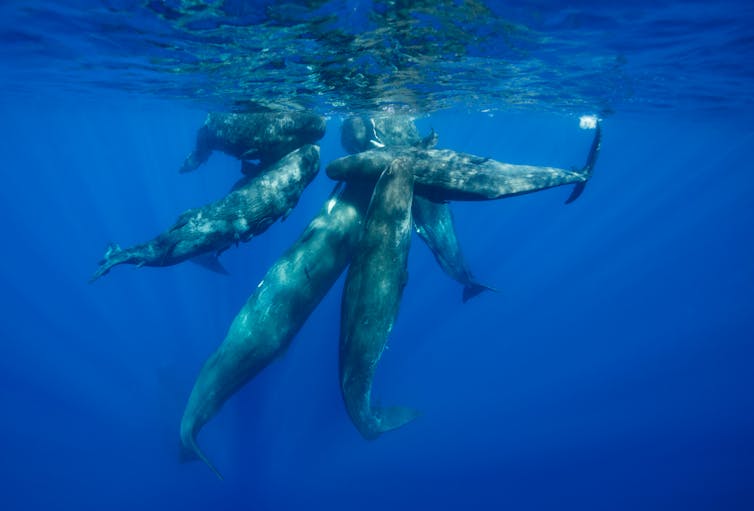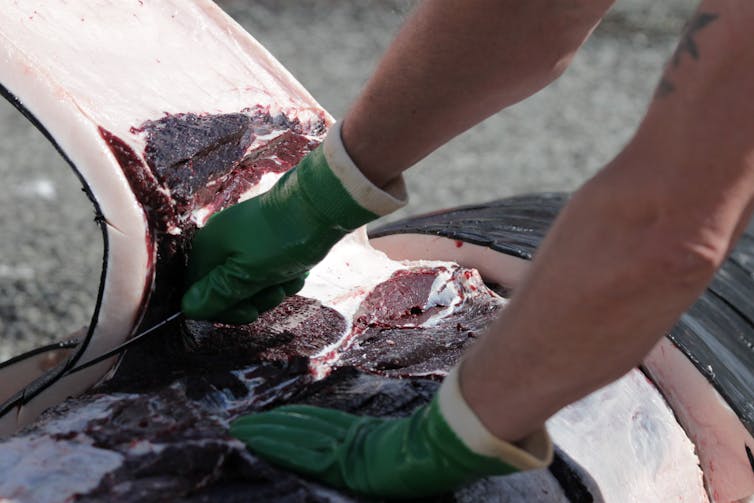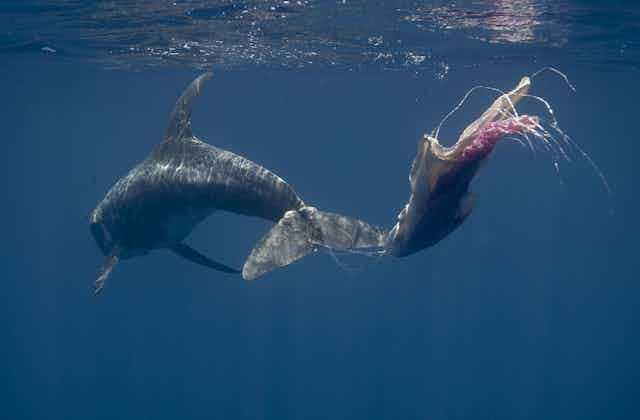Marine mammals – animals including whales, dolphins, seals, sea lions, sea otters, dugongs and manatees – are threatened by an array of human activities. Species such as the North Atlantic right whale, Rice’s whale and Vaquita porpoise have been pushed to the brink of extinction.
Plastic debris poses a particularly significant problem. Marine mammals mistakenly eat items such as plastic bags, food wrappers, ropes and abandoned fishing gear, or they become entangled in plastic items including fishing nets. Both scenarios can lead to injury and, in many cases, death.
Autopsies carried out on 34 dolphins and whales stranded along the Greek coastline in 2019 found that nine of them (from four different species) had ingested plastic – and plastic consumption was identified as the cause of death in three of these animals.
And now, a recent US study has revealed that marine mammals face a more subtle plastic threat: microplastics.
In the ocean, microplastics (tiny plastic particles measuring less than 5mm) commonly accumulate in an animal’s gills or digestive tract. However, the recent study found microplastics in various other tissues of a number of different whale, dolphin and seal species.
This suggests that microplastic particles are somehow able to move from one part of an animal’s body to another (or “translocate”). This finding may carry health implications not only for marine mammals, but humans too.

Contaminated tissues
The researchers obtained tissue samples from 32 individual animals spanning 12 marine mammal species. These animals had either been stranded or harvested between 2000 and 2021.
Samples were taken from the animals’ blubber, melon (the fatty structure found in a whale’s forehead), acoustic fat pads (from the jaw), and lung tissue. These all serve vital functions such as enabling marine mammals to breathe, hear, locate prey and keep warm.
Analysis of the samples revealed that every single melon, acoustic fat pad and lung tissue sample contained microplastics, as did 64% of blubber samples. The particles in the tissue samples ranged from very small (24µm) to relatively large (1,387µm).
Tiny particles, big impact
Research has provided us with some understanding of how microplastics may affect small marine animals. At Plymouth Marine Laboratory, we have shown that exposure to microplastic particles can affect feeding, growth and reproduction in animals that filter seawater or sediment for food.
Evidence of the impact of microplastics on larger animals is, by comparison, limited. This is because our understanding largely stems from observations of animals that are dead.
Nonetheless, studies have shown that microplastic fragments can cause the formation of scar tissue in the stomachs of seabirds. And there are also concerns that the chemicals present in marine plastic litter may leach into the tissues of marine mammals upon ingestion.
It’s therefore possible that the movement of microplastics from seawater and prey items into the tissues of marine mammals may affect their health. In the most severe scenario, the accumulation of these particles could lead to a loss of these tissues’ critical functions. However, further understanding of the implications of microplastic presence in body tissues is needed.
A concern for human health?
The fact that microplastics can accumulate in body tissues could also mean that more plastic particles are transferred further up the food chain to top predators like humans than is currently thought.
It’s generally believed that only very small microplastics (particles less than 100µm) can move from the gut or respiratory system into the bloodstream. This would limit the amount of microplastics that are consumed when eating marine vertebrates.
But the US study has found the presence of larger microplastic particles in non-digestive tissues, suggesting this assumption might not hold true. Separate studies in the Persian Gulf and Black Sea have also revealed a variety of microplastic sizes present in non-digestive tissues of commercial fish.
Together, these findings could have implications for human health. Marine mammal meat and blubber are an important food source within certain Indigenous communities. And many people consume fish as part of their diets.

The risk of ingesting microplastics from a seafood meal is, at present, lower than that from drinking bottled water. But the prevalence of microplastics in the marine environment is rapidly increasing, and it is now evident that these particles can enter the bloodstream of animals and humans too. Research has found microplastic particles in human blood samples and in human placenta.
Laboratory studies have managed to highlight the generally negative impacts of microplastic exposure on small fish and invertebrates. However, we still lack a full understanding of the consequences of microplastic ingestion for larger mammals such as whales, dolphins, and humans.
What we are certain of is the escalating abundance of microplastics in the marine environment – our oceans are now filled with over 170 trillion plastic particles. Efforts to stop the flow of plastic into the marine environment are urgently required.

Don’t have time to read about climate change as much as you’d like?
Get a weekly roundup in your inbox instead. Every Wednesday, The Conversation’s environment editor writes Imagine, a short email that goes a little deeper into just one climate issue. Join the 20,000+ readers who’ve subscribed so far.

